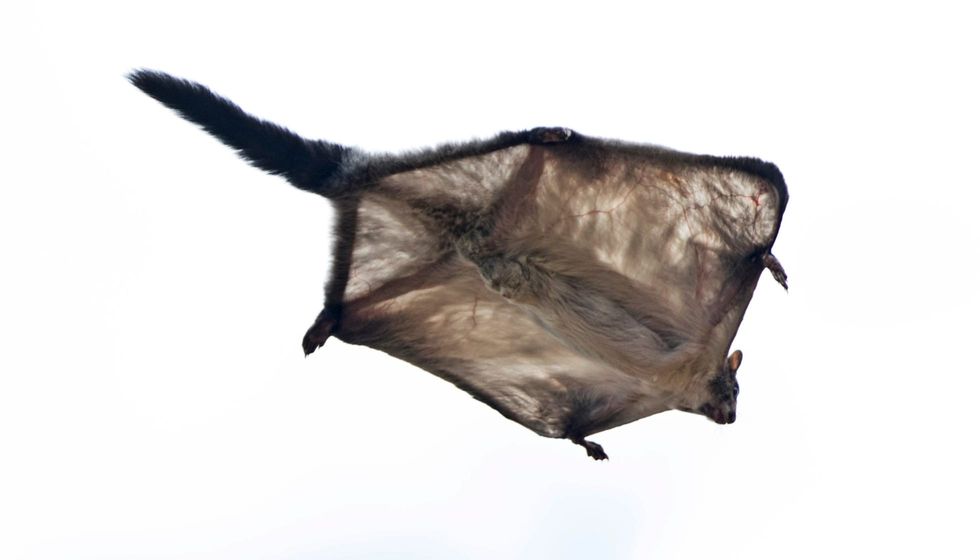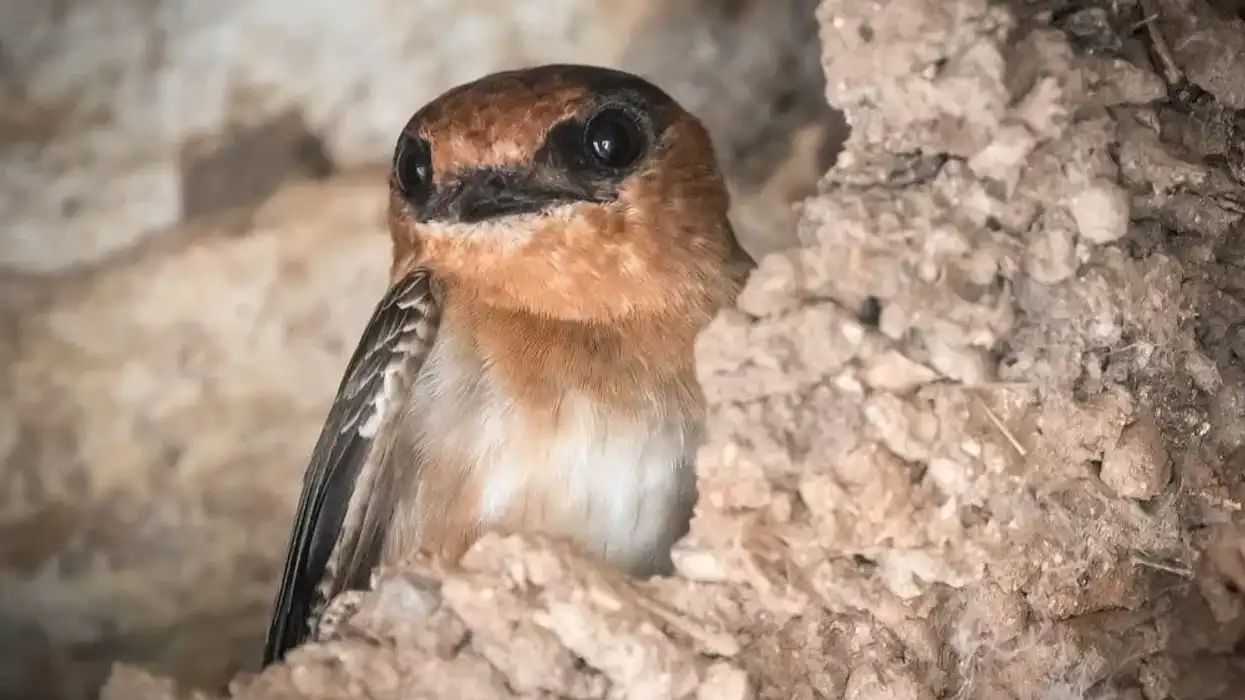There are several species of the giant flying squirrel found in several countries of South Asia and Southeast Asia such as China, India, Laos, Myanmar, Sri Lanka, Taiwan, Thailand, and Vietnam. These rodents belong to the family of Sciuridae.
The prominent giant flying squirrel species are the red giant flying squirrel (Petaurista petaurista) and the Indian giant flying squirrel (Petaurista philippensis). The former species are reddish-brown while the latter are gray-brown in color.
The red giant flying squirrel is quite large compared to the Indian giant flying squirrel. The squirrels are around 11 in–1 ft 9.5 in (28.5-55 cm) long and 2.2-7.1 lb (990-3200 g) in weight that makes them one of the largest squirrels in the world. The average litter size of the giant flying squirrel is around one or two.
The squirrels are nocturnal are remain active during the night. They are best known for gliding between trees by spreading their skin between the limbs known as patagia. The Internation Union for Conservation of Nature has listed the species in the Least Concern category.
Keep on reading to learn more interesting facts about the Giant flying squirrel. If you want to know more exciting information about different animals, check out the Japanese giant flying squirrel and Red and white giant flying squirrel.
Giant Flying Squirrel Interesting Facts
What type of animal is a Giant Flying Squirrel?
The giant flying squirrels are rodents, more specifically squirrels. These squirrels are herbivores and they primarily prey on plants, moss, seeds, nuts, fruits, flowers.
What class of animal does a Giant Flying Squirrel belong to?
The giant flying squirrels belong to the family of Sciuridae and Petaurista genus.
How many Giant Flying Squirrels are there in the world?
The exact population of the giant flying squirrels is not known but the species is found throughout the South Asian region. The population of a similar species, the Japanese giant flying squirrel that belongs to the same genus of Petaurista, has been declining over the years.
Where does a Giant Flying Squirrel live?
The giant flying squirrels are found in several countries such as China, India, Sri Lanka, Myanmar. The species are also widely distributed throughout Southeast Asia. The flying squirrel species is also found in countries such as Laos and Vietnam.
What is a Giant Flying Squirrel's habitat?
These flying squirrels are found in dry deciduous forests, broadleaf forests, and temperate forests. The squirrels live also in the scrub forests in both lowlands and montane areas.
Who do Giant Flying Squirrels live with?
Most of the giant flying squirrels are alone while some live in groups. The mothers, primarily live with their babies or young squirrels for a few months after their birth. Also, the northern flying squirrel found in the countries of North America lives in groups of six to eight squirrels.
How long does a Giant Flying Squirrel live?
The exact lifespan of the giant flying squirrel is not known but several species of the flying squirrel live for around 10 years. If kept in captivity, the species can live more.
How do they reproduce?
Like other species such as the Northern flying squirrel of North America, the giant flying squirrel follows the same reproduction process. The courtship behavior mainly includes chasing the partners during the breeding season.
As the species is found throughout the South Asian continent, the breeding season varies from region to region. In Indian states, babies are born in May or June.
In Taiwan, the species breed in two different seasons, one in January and the other in August. While the species found in Malaysia generally breed in the month of February.
The incubation period lasts for around 30-40 days and the female squirrels give birth to around one or two babies. Their babies or pups are born blind with heads bigger than their bodies. The female squirrels take care of the young ones for a few months.
What is their conservation status?
These squirrels are quite common rodents found in different parts of the South Asian continent. Also, the International Union for Conservation of Nature has listed the species in the Least Concern category but over the years the population has been declining.
The main reason behind the contraction of the number is habitat loss. As the species have gliding abilities and they fly with the help of the skin between their limbs known as patagia, people illegally capture them.
Giant Flying Squirrel Fun Facts
What do Giant Flying Squirrels look like?
The giant flying squirrels are best known for their parachute-like membrane that helps them to glide. There are several species of these squirrels that are primarily found in several countries of South Asian countries.
They are either reddish-brown or gray-brown in color. Their pups or the young squirrels are also very beautiful and when they are born, their heads are comparatively larger than their bodies. Their babies are born blind.
They are nocturnal and remain very active during the night. With the help of their patagia, they are able to cover shorter distances. The special skill also helps them to fool their predators.
How cute are they?
These flying squirrels are some of the most adorable and cute creatures. They are large and fluffy, and their ability to glide, giving them the name of 'flying' squirrels, is fascinating.
How do they communicate?
Like other species of flying squirrels, the giant flying squirrels use similar methods of communication. These mammals use different sounds to call their partners and group members. Also, they chirp loudly to indicate danger. Research also reveals that these flying squirrels use the sense of smell and touch to communicate with each other.
How big is a Giant Flying Squirrel?
As the name suggests, these flying squirrels are very huge in size. The average weight and length of the mammals are 2.2-7.1 lb (990-3200 g) and 11 in–1 ft 9.5 in (28.5-55 cm) respectively.
A few of the squirrels found in the northeast part of India are almost twice the size of the red and white giant flying squirrel. These flying squirrels are also twice the size of the northern flying squirrel.
How fast can a Giant Flying Squirrel move?
The exact speed of the flying squirrels is not known as of now but these animals are best known for their gliding skills. They are quite flexible and can easily deceive their predators with their exceptional skills.
How much does a Giant Flying Squirrel weigh?
The average weight of the giant flying squirrels is 2.2-7.1 lb (990-3200 g).
What are their male and female names of the species?
There are no specific names given to the male and female species of giant flying squirrels.
What would you call a baby Giant Flying Squirrel?
People generally call the babies or the young flying squirrels by the term pups.
What do they eat?
Like most of the species of the flying squirrels, the giant flying squirrels live on trees and primarily prey on plants, moss, seeds, nuts, fruits, and flowers.
Are they dangerous?
These flying squirrels are nocturnal and also love to be alone, they generally do not come close to humans and pose no threats. But if someone tries to come closer to their nests, the squirrels can bite and they do have sharp teeth.
Would they make a good pet?
By looking at their uncommon membrane and exceptional gliding abilities, everyone would love to have a pet like the giant flying squirrels. Also, the flying squirrels could be very friendly to humans if kept from birth but in a few countries of North America, keeping a northern flying squirrel is illegal.
It is also unclear whether the giant flying squirrel is legal to keep in countries of South Asia. Providing them with a suitable habitat where they can glide between the trees would also be near impossible.
Did you know...
In India, the Indian giant flying squirrels were considered as a subspecies of the red giant flying squirrels until the 1980s.
The red giant flying squirrels are found in lowlands where altitudes remain below 3000-3300 ft (900-1000 m) while the red and white squirrels inhabit forests at altitudes of 3000-11000 ft (800-3500 m). The latter species is also known as the Taiwan giant flying species.
The Indian giant flying squirrels are best known for mimicking the spot-bellied eagle-owl. With such a voice, the squirrels easily deceive their predators.
People often think these squirrels fly but these species actually glide.
Different types of Giant Flying Squirrel
There are several species of giant flying squirrels found in different South Asian countries, and these are the red giant flying squirrels, the Indian giant flying squirrels, and the red and white giant flying squirrels.
The most common among all three is the red giant flying squirrels. They are found in China, India, Sri Lanka, and a few countries of Southeast Asia as well.
They have reddish-brown fur while the Indian giant flying squirrels have gray-brown fur. The red and white giant flying squirrel is endemic to China and Taiwan, and the squirrels have a white-colored face which makes them more unique.
How far and fast can they glide?
These flying squirrels have a parachute-like membrane i.e. skin between their limbs known as patagia which helps them to glide.
They travel between trees and cover a minimum distance of at least 330-490 ft (100-150 m) in one glide. Some flying squirrels even cross the mark of 1480 ft (450 m). The membrane helps them to protect themselves from several predators in forests.
Here at Kidadl, we have carefully created lots of interesting family-friendly animal facts for everyone to discover! Learn more about some other mammals including the American marten, or Rodrigues flying fox.
You can even occupy yourself at home by drawing one on our Giant flying squirrel coloring pages.










